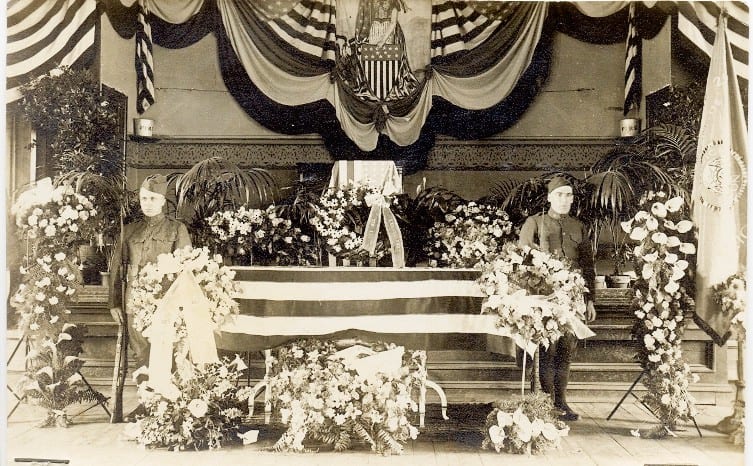The time when a masquerade dance prevailed at Town Hall over a Saugus soldier killed in World War I
By Janice K. Jarosz
Château-Thierry, Vaux and Bouresches were not the only battlegrounds during World War I. A delayed battle was being waged in our town of Saugus, Massachusetts, in the spring of 1922 despite the fact that the Treaty of Versailles was signed on June 28, 1919. Protests and pickets were held in Saugus, and the conflict pitted brother against brother, patriot against partygoer, and one person’s values against another’s. No blood was shed and no prisoners taken but the incident stirred up the passions of all Saugonians on both sides of the conflict, leaving scars that lasted for generations.
Before I reveal this, up to now, little known battle in Saugus, I must disclose that one of the main characters was my great uncle, Henry A. Parker. Uncle Henry was not only the Town Clerk and Tax Collector at the time, but also the President of the then famous, and maybe sometimes infamous, Saugus Tennis and Canoe Club – THE club to belong to in town; you were someone special in Saugus if you held a membership card.
It was April 1922 and for the past 16 years the Saugus Tennis and Canoe Club had held a masquerade dance at the Saugus Town Hall on Saturday night just after Easter. Invitations had been sent out, costumes ordered, refreshments and decorations agreed upon. Actually, it was just like any other yearly dance. Plans were all made with Mr. Parker and his dance committee and all arrangements were agreed upon and finalized.
On the other front across the pond, Private Winslow Hodgdon, an adopted son of Mrs. Olive M. Batson, 384 Central Street, Saugus, was wounded in France, according to a report on May 16, 1918, near the end of the war. He must have lingered for a while, never recovering from his wounds, as death records indicate he died in 1921 while still in France, and his body was finally being returned to Saugus for burial.
Private Hodgdon was the first lad from Saugus to be killed in action in World War I. And, according to military customs, the body must lie in state for at least 24 hours prior to interment, or in this instance, from Saturday, 12 noon to Sunday at 2 p.m. It was Mrs. Batson’s wish that the funeral be held the Sunday after Easter, and she decided that the Town Hall was the only proper and fitting place to hold the services, as the First Parish Universalist Church was not large enough to accommodate the anxious family, citizens and soldiers to pay tribute to the fallen hero.
As soon as Past Commander Benjamin Q. Belonga of the Saugus Post 210, who headed the committee of funeral arrangements, learned of the Tennis and Canoe Club’s planned annual masquerade dance, the cooperation of those in charge was sought, and Mr. Belonga was confident that, under the circumstances, the Club would gladly postpone the affair. Sunday evening, and just six days before the gala event, Mr. Belonga called at Henry Parker’s residence and spoke with his daughter, Marion Parker, who, by the way, was a longtime member of the Dance Committee. Mr. Belonga suggested that a postponement of the dance was in order so that Private Hodgdon’s body might lie in state. Miss Parker’s reply is purported to have been to the effect that costumes had been hired, invitations sent out, orchestra engaged and decorations contracted. But, other than that, she would, indeed, speak to her father.
Two days later, on Tuesday evening, April 18, 1922, members of the Legion Post 210 voted that a committee would visit Mr. Parker, along with the directors of the club as well, to see if it would be possible to postpone the dance until the following week. Post Commander John B. Haley selected George Sprague, Abner McKenzie, Clarence Howard and Raymond Clark, and on April 19, 1992, they called on Parker at his home.
Commander Haley opened the conversation by asking if it would be possible to postpone the dance. Mr. Parker asked how that could be done. Mr. Haley suggested a mailing be done announcing the postponement and went on to state that members of the Legion Post had over a year and half to plan for the soldiers’ funeral and that it looked to him that those in charge had bungled the whole affair.
Haley spoke of the change in plans because of the small capacity of the church and that they did not know that the Town Hall was already occupied. (Evidently, none of the Legion men belonged to the Club.)
Mr. Parker explained to the members of the Legion Committee that the Club has rented the hall on the same night for the past 16 years. He then asked why they did not plan the funeral on the Sunday before (which would have been Easter) or on the 19th?
After further conversation, Mr. Haley asked Mr. Parker if he believed that the dance should take precedence over the funeral of the first Saugus boy to be returned from France; a boy who ate bully beef and hardtack in the trenches and gladly gave up his life that the dance might be held.
Mr. Parker asked the committee if they would be willing to pay all expenses incurred by a postponement, and Mr. Sprague replied that they would. However, Parker still felt that the plans could not be changed, and when he stated so, someone in the group threatened him by saying that he would be the loser. With that, Mr. Parker asked the committee members to leave his residence, and they did.
Despite the protests of hundreds of citizens, members of the Saugus Post 210 and residents of many other Saugus organizations attended the annual masquerade ball of the Club, and it was conducted with the usual revelry of former years, while the body of Winslow Hodgdon lay in an undertaker’s morgue, distinctly contrary to plans hitherto made.
According to a statement found in The Lynn Telegram: “The dance went forward because so much money was spent by the committee and they could not see fit to cancel the date so that the body of the Saugus hero could lie in state in the Hall. All during the evening of the dance, crowds of ex-servicemen picketed the streets. The Post took no part of the picketing, according to its members, but their influence was duly noted. The crowd of picketers was orderly, parading up and down in front of the scene of festivities and its solemn silence displayed the deep sincerity of the protest.”
Some of the protesters carried banners deploring the attitude of the Club members. “Enjoy yourselves, Canoe Club people while a hero lies in the morgue, and if you dance tonight, you slight him,” was printed on the banners. Some dancers changed their minds and joined in with the protesters. Many of those who attended the dance wore their masks when they entered the dance hall/Town Hall, hoping that their costumes would keep them from being recognized by their friends, family and neighbors.
Sunday, the day after the dance, a final tribute was paid to Private Hodgdon at a military funeral held at Saugus Town Hall, which had been swept clean of any party remnants. The body of the deceased hero lay in state from 8 a.m. to one half-hour before the service. The pallbearers, all of whom were World War I veterans, were Leo Parley, Harold Smiledge, James H. Rodgers, Alex Jackson, Edward H. Davis, Raymond P. Chesley, Charles Chesley, Welcome W. McCullough, Wilton McKenney, George Parrott Jr. and Edwin Jaquith. Private Hodgdon was buried in Riverside Cemetery surrounded by dozens of mourners.




